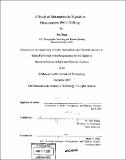A study of seismoelectric signals in measurement while drilling
Author(s)
Zhan, Xin
DownloadFull printable version (4.464Mb)
Other Contributors
Massachusetts Institute of Technology. Dept. of Earth, Atmospheric, and Planetary Sciences.
Advisor
M. Nafi Toksöz.
Terms of use
Metadata
Show full item recordAbstract
An LWD acoustic wave can move the excess charge in the electric double layer along the borehole wall to generate a streaming electric field. This thesis is an experimental and theoretical investigation of the electric field induced by the multipole LWD acoustic wave. The main goal of this thesis is to understand the mechanism in the seismoelectric conversion under the LWD geometry and prove the absence of the tool mode in the LWD-acoustic-wave induced electric signals. In this experimental study, we measured the seismoelectric signals excited by an acoustic multipole source in the scaled logging-while-drilling model. We put the scaled tool in a sandstone borehole to perform LWD seismoelectric and acoustic measurements. Monopole and dipole acoustic and the induced electric signals were recorded separately under exactly the same settings. The recorded acoustic and seismoelectric signals were analyzed in both time and frequency domains using a semblance method. We found no tool mode components in the electric signals by examining both the waveforms and the time and frequency domain semblances. (cont.) The underlying mechanism is the electric double layer (EDL) at the steel water interface is much weaker than the one at the formation water interface. Thus, in the LWD seismoelectric signal, there should be no component with an apparent velocity of tool mode. Since only formation acoustic modes have their corresponding components in the electric signal, we calculated the coherence of the two kinds of signals in the frequency domain. By applying the coherence curve to filter the acoustic signals, we can eliminate the tool modes and pick out the formation acoustic modes. In the theoretical study, we developed a Pride-theory-based model for the LWD-acoustic-wave induced electric field. The electric field strength is calculated at the electrode positions along the borehole wall, analogous to what was done in the experiment. The electric boundary conditions, which are the continuity of the electric field at the borehole wall and disappearance at the LWD tool surface, reveal the underlying mechanism in the LWD seismoelectric conversion which is also the basis of our lab experiment. The absence of the tool modes in the synthetic waveforms of the electric field coincides with what we have observed in the experimental study. (cont.) Both the experiment and the theoretical results confirm that measuring the seismoelectric signal generated by an acoustic multipole source during the LWD process can be an effective way to eliminate the tool wave contamination on the LWD acoustic measurements. This thesis research shows that seismoelectric logging-while-drilling may be a potential new method in formation property evaluation.
Description
Thesis (S.M.)--Massachusetts Institute of Technology, Dept. of Earth, Atmospheric, and Planetary Sciences, 2005. Includes bibliographical references (leaves 93-98).
Date issued
2005Department
Massachusetts Institute of Technology. Department of Earth, Atmospheric, and Planetary SciencesPublisher
Massachusetts Institute of Technology
Keywords
Earth, Atmospheric, and Planetary Sciences.